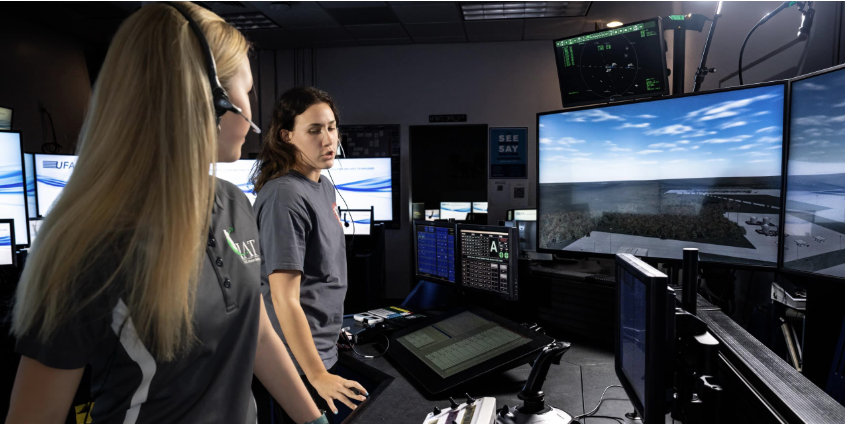The Department of Applied Aviation Sciences offers four bachelor's degree programs, each unique: Space Operations, Air Traffic Management, Aviation and Aerospace Safety, and Meteorology.
Each program is very different from the others. However, all are good choices for students who want challenging and rewarding careers working in direct contact with aviation or aerospace but who may not be interested in flight.
For example, the Space Operations program helps students work in training, management, safety, policy, mission operations and planning of space programs. This program helps students fill an expanding need in a growing, innovative field.
The Air Traffic Management program prepares students to work as air traffic controllers, airline dispatchers, or simulation specialists.
Aerospace and Occupational Safety gives students gain the knowledge and the expertise needed to address safety concerns in aviation, aerospace operations, as well as most businesses and industries across the globe. Graduates of the AOS program have gone on to fill key safety management roles in both the public and private sectors.
The Meteorology programs prepare students to be forecasters and researchers in the field of meteorology and weather analysis or to be broadcasters or briefers who provide weather-related information on the air or online.
The department's facilities include high-definition simulators for air traffic control, a crash lab where students get to experience forensic investigation of aircraft accidents, and a meteorology lab with specialized equipment for broadcasting and forecasting. These programs ensure students graduate with hands-on experience using highly advanced technology.
Visit the website of the Department of Applied Aviation Sciences
Submissions from 2007
Space Suit Concepts and Vehicle Interfaces for the Constellation Program, D. M. Klaus, J. Metts, R. Kobrick, M. Mesloh, T. Monk, and et al.
The Native American and European Perception of Place in the New World, Mary Snow
Evolution of the American Ecological Paideia, Mary Snow and Richard K. Snow
Lightning Signature Assessment to Forecast Tornado Formation, Mary Snow, Richard Snow, and Nicole Kufa
A Multimedia Approach to Climate Change Education, Richard Snow and Mary Snow
GIS Assessment of Environmental Impacts on Urban Forests, Richard Snow and Mary Snow
GIS Analysis of Lightning Strikes within a Tornadic Environment, Richard Snow, Mary Snow, and Nicole Kufa
Submissions from 2006
Two-Factor Authentication for Online Banking Applications, Gary C. Kessler
Day/Night Visible Satellite Images, Frederick R. Mosher
Innovative Schematic Concept Analysis for a Space Suit Portable Life Support Subsystem, M. Schuller, R. Kobrick, T. Lalk, L. Wiseman, F. Little, and et al.
Submissions from 2004
An Overview of Steganography for the Computer Forensics Examiner, Gary C. Kessler
Submissions from 1999
The Web Can Be Suitable for Learning, Gary C. Kessler, Ken Rosenblad, and Steven D. Shepard
Submissions from 1994
Simulations of the Effects of Water Vapor, Cloud Liquid Water, and Ice on AMSU Moisture Channel Brightness Temperatures, Bradley M. Muller, Henry E. Fuelberg, and Xuwu Xiang
Submissions from 1993
An Alternative Representation of the Ice Canopy for Calculating Microwave Brightness Temperatures Over a Thunderstorm, Bradley M. Muller, Henry E. Fuelberg, and Eric A. Smith
Submissions from 1990
A Simulation and Diagnostic Study of Water Vapor Image Dry Bands, Bradley M. Muller and Henry E. Fuelberg
Submissions from 1986
Earth Observing System, volume IIa: Data and Information System, Report of the EOS Data Panel, Raymond Arvidson, Frederick Billingsley, Robert Chase, Pat Chavez Jr., Michael Devirian, Frederick Mosher, and et al.
Submissions from 1985
Functional and Performance Requirements of the Next NOAA-Kansas City Computer System (Appendix G), Frederick R. Mosher
Impacts of Interactive Processing Systems on the Forecasting Ability of the National Severe Storms Forecast Center (Appendix E), Frederick R. Mosher
Lessons Learned from the CSIS [Centralized Storm Information System] (Appendix D), Frederick R. Mosher and Joseph T. Schaefer
The Frontal Hydraulic Head: A Micro-α Scale (~1 km) Triggering Mechanism for Mesoconvective Weather Systems, M. A. Shapiro, Tamara Hampel, Doris Rotzoll, and F. Mosher
Submissions from 1982
Diurnal Distribution of Very Heavy Precipitation Over the Central and Eastern United States, Kenneth A. Crysler, Robert A. Maddox, L. Ray Hoxit, and Bradley M. Muller
Submissions from 1981
Meteorological Significance of Cloud Tracked Winds During DST-5 and DST-6, H. M. Goodman, Frederick Mosher, Tod Stewart, and Verner Suomi
Characteristics of Water Vapor Tracked Winds, Frederick R. Mosher
Submissions from 1980
A Model for Calculating Desert Aerosol Turbidity Over the Oceans from Geostationary Satellite Data, Carl C. Norton, Frederick R. Mosher, Barry Hinton, David W. Martin, David Santek, and William Kuhlow
Submissions from 1979
An Investigation of Surface Albedo Variations During the Recent Sahel Drought, Carl C. Norton, Frederick R. Mosher, and Barry Hinton
Shallow Convection on Day 261 of GATE: Mesoscale Arcs, C. Warner, J. Simpson, D. W. Martin, D. Suchman, F. R. Mosher, and R. F. Reinking

